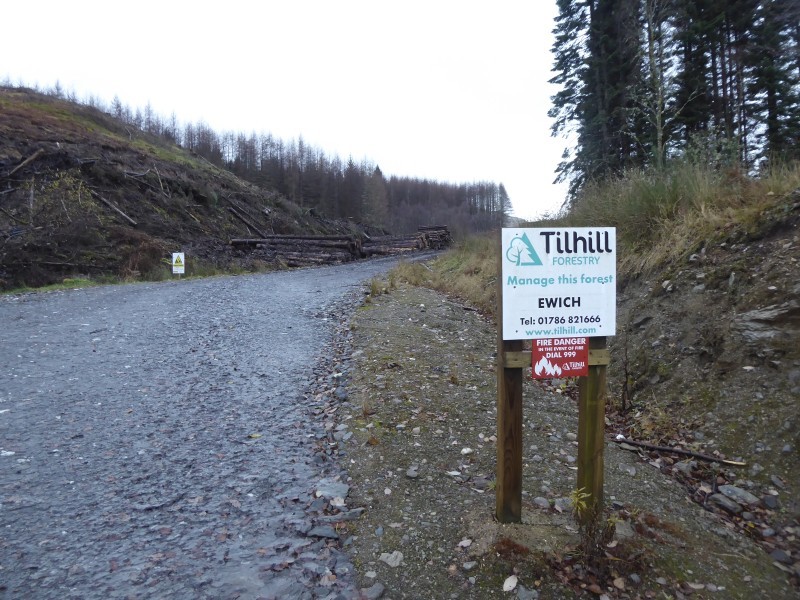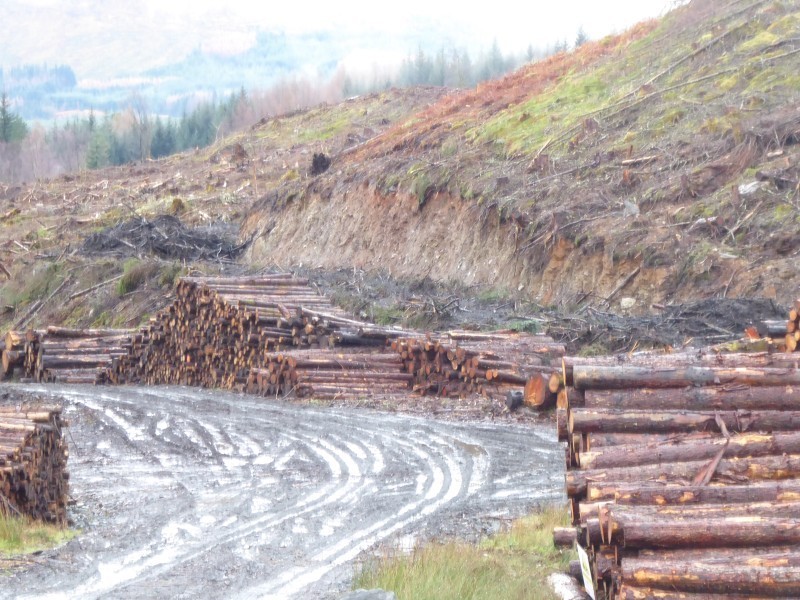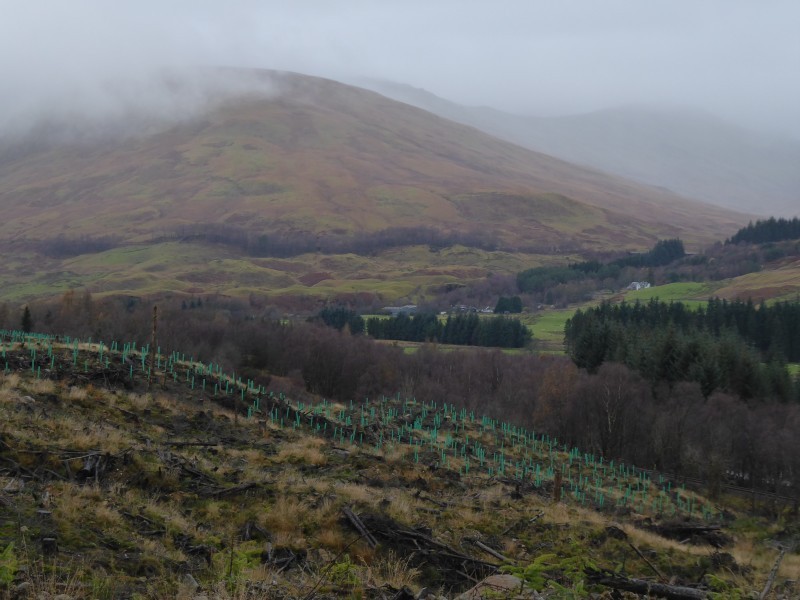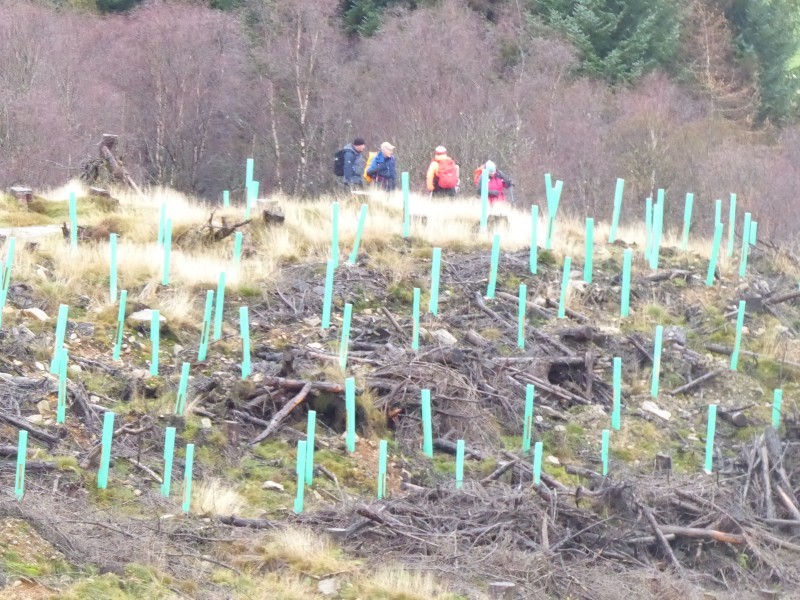
I am not sure when I first saw the bright green plastic tree tubes on the left of the A82 heading north from Crianlarich but on Saturday I stopped to have a look.
The site is much easier to access than previously as in 2020 the Loch Lomond and Trossachs National Park Authority granted planning permission to widen the junction of the old track with the A82 (see here for planning papers).

This area formed part of the Ewich Forest which was sold off by Forest and Land Scotland in 2019-20 (see here). The sales details are still not on the online Registers of Scotland but Tilhill manages the property and commenced felling sometime after February 2021 after they had been granted approval for 6.5km of new forest road.

Forest harvesting in Scotland has become an increasingly brutal affair. Its not just the clear fell but the huge tracks, the cuts across hillsides, the way felled trees are used to create a firm surface from which harvesting vehicles can operate and the large amount of wood that is wasted
The UK Forestry Standard, a revised version of which was recently approved by Scottish Ministers, does not prevent any of this. Lip service is paid to the importance of soils and landscape but the reality is very different as the photo shows.

The new UK Forestry Standard includes guidance that owners should :
“Manage a minimum of 15% of the forest management unit with conservation and the
enhancement of biodiversity as a major objective.”
Hence why parts of the Ewich conifer plantations are now being planted with native trees but in a way that just adds to the destruction. The problem is that there are far too many deer for native trees to survive,:
“In areas where deer are present, deer management measures should be developed and
implemented as part of a management plan, with the aim that deer browsing does not
prevent regeneration of trees or the development of resilient forests; ideally this will be in co-operation with neighbours or as part of a Deer management Group.”
It would appear Tilhill Forestry are either spending too little money on deer management or have no confidence that they can prevent incursions of deer from neighbouring landholdings, hence the plastic tree shelters. In about a third of third of the shelters I looked at the saplings were already dead so the plastic was serving no useful purpose.
The revised UK Forestry Standard recognises the damaging impact of plastic on soils recommends tree shelters should be removed and recycled after use. That revised advice came too late for Ewich Forest but there are serious concerns about how it be enforced. It would be far better to pay stalkers to shoot deer, removing the need for tree tubes, than to pay people to collect them after they have started to break-up and shed plastic into the natural environment.

The West Highland Way crosses through the site. One wonders what the many visitors from the continent who walk it must think of scenes like this? In the Alps and Pyrenees forests regenerate naturally with almost no planting and no plastic tree shelters, simply by keeping grazing under control,
Ewich Forest is part of the Inverary and Tyndrum Deer Management Group. It includes the Auchreoch Estate, which has for a long time failed to protect Coille Coire Cuilc effectively (see here), and the Strone Estate, where landslips have affected the A82 (see here). Plastic tree tubes, dying remnants of Caledonian Pine Forest, landslips, three apparently very different problems but with a common cause – grazing pressure resulting from a failure to control deer numbers.
So has the Loch Lomond and Trossachs National Park Authority made any difference? Well, its supported fencing to protect native woodland on both the Strone Estate and Coille Coire Chuilc, rather than deal with the real problem, the number of deer. And its helped plaster Balquhidder in plastic (see here), rather than deal with the real problem,the number of deer and sheep. The LLTNPA is therefore hardly in a position to advise Tilhill to stop polluting the natural environment with plastic or to employ local stalking staff.

Hi Nick
These problems are incredibly widespread and endemic to forestry. Loch Lomond National Park does seem incredibly lax on this issue… captured by the landowners I guess. Also, there are virtually no foresters on the ground anymore to see this level of harm and destruction.
As you point out the real problem lies with this countries’ incredibly soft approach to deer management. It is time to introduce a legal responsibility to manage deer to sustainable levels on all landowners. This will allow woodlands to regenerate even after decades of overgrazing and will create jobs and add value in the rural economy. Not to mention giving young people to engage directly with nature and healthy food production.
Another article from Nick which tries to make out that everything is the fault of the National Park. Clearly not the case – the application to widen the road would have been dealt with on its own basis and wouldn’t have taken into account how the commercial plantation was managed. None of the land at any of these sites is under ownership of the National Park so they wouldn’t have had any control over deer levels – if something needs to be done about that then it’s down to the SG not the NP.
Difficult to see the justification for criticising the NP in any matter here – but that wouldn’t suit Nick’s agenda.
Am I right that you don’t think our National Parks should be doing anything to influence land-use? My agenda is that I do believe National Parks should be making a difference – why would we have them otherwise? And if our National Parks do not have the necessary powers they should be telling the Scottish Government what they need so they can make a difference.